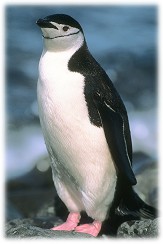 |
Teacher Background  The wildlife of Antarctica is uniquely adapted to withstand the harsh conditions of this region. The seven penguin species found in the Antarctic are the Adelie, Chinstrap, Emperor (of "March of the Penguins" fame), Gentoo, King, Macaroni and Rockhopper. The six seal species are the Antarctic fur seal, Crabeater, Leopard, Ross, Southern Elephant and Weddell. Six species of whales belonging to the southern baleen group make their home in Antarctica for at least part of the year: Blue, Fin, Humpback, Minke, Sei, and Southern Right. Six different species of toothed whales are commonly seen in Antarctic waters: Sperm, Orca, Southern Bottlenose, Southern Four-tooth and Hourglass, and Southern Right Whale dolphins. There are more than 40 species of flying seabirds and landbirds, with Skuas, Petrels, Gulls, and Cormorants among the more common. Banding and recovery studies show that some Antarctic birds travel throughout the world. The wildlife of Antarctica is uniquely adapted to withstand the harsh conditions of this region. The seven penguin species found in the Antarctic are the Adelie, Chinstrap, Emperor (of "March of the Penguins" fame), Gentoo, King, Macaroni and Rockhopper. The six seal species are the Antarctic fur seal, Crabeater, Leopard, Ross, Southern Elephant and Weddell. Six species of whales belonging to the southern baleen group make their home in Antarctica for at least part of the year: Blue, Fin, Humpback, Minke, Sei, and Southern Right. Six different species of toothed whales are commonly seen in Antarctic waters: Sperm, Orca, Southern Bottlenose, Southern Four-tooth and Hourglass, and Southern Right Whale dolphins. There are more than 40 species of flying seabirds and landbirds, with Skuas, Petrels, Gulls, and Cormorants among the more common. Banding and recovery studies show that some Antarctic birds travel throughout the world.Penguins are designed for life in the sea. Some species spend as much as 75% of their lives in the water, though they lay their eggs and raise their chicks on land. A streamlined body, paddle-like feet, insulating blubber, and feathers for waterproofing all add to their efficiency and comfort underwater. Heavy, solid bones act like a diver's weight belt, allowing them to stay submerged. Their wings, shaped like flippers, help them "fly" underwater at speeds of up to 15 mph. They also have a remarkable deep-diving ability. In addition to blubber for insulation, penguins have stiff, tightly packed feathers (up to 70 per sq. in.) which overlap to provide waterproofing, coated with oil from a gland near the tail to increase impermeability. Their distinctive black and white shading makes them nearly invisible to predators from above and below. Like most birds, penguins have little or no sense of smell (a boon for those in a crowded penguin rookery!) Like other birds, their sense of taste is also limited. Scientists suspect they may be nearsighted on land. Their vision appears to be better when they're underwater. Penguins are considered to be the most social of birds. Rookeries may contain thousands of individuals. (As many as 24 million penguins visit the Antarctic continent!) Even at sea, they tend to swim and feed in groups. Most species of penguins build nests, but the nests may consist only of a pile of rocks or scrapings or hollows in the dirt. Emperor penguins build no nests; they hold the egg on top of their feet under a loose fold of skin called the brood patch. Objectives
Discuss how quickly our bodies are chilled in cold. Brainstorm ways in which penguins and other animals are well-adapted to cold water and icy environments (blubber, air in feathers, oil on fur, low surface area to volume ratio). Then complete the following demonstrations:
Activity 1: Blubber Glove! Explore/Explain Materials (for each team of students):
Follow-up: Penguin parents work in teams incubating their eggs. One parent keeps the egg warm, while the other goes off to feed on krill and fish. Gentoo parents trade off every day, while Adelies switch every two weeks. How do the Adelies survive while sitting on the nest for this length of time? What are some other Penguin strategies for nesting and incubating? Adapted with permission from The Aquarium of Maine web pages: Activity 2: Create a New "Antarctic Adaptable" Materials:
Both of the above activities are excerpted from P2K's LIVE FROM ANTARCTICA 2 Teacher's Guide.
For more information go to passporttoknowledge.com/antarctica |
 |
|
Polar Palooza Home | About The Poles | About Polar Palooza | The Travelers Educator's Corner | Sites and Cities | The HDvCC | Media Palooza Supplies & Resources | Credits & Contacts | Site Search | Polar Palooza Blog  POLAR-PALOOZA and the materials on this website are based upon work supported by the National Science Foundation under Grant No. 0632262. Any opinions, findings and conclusions or recommendations expressed in this material are those of PASSPORT TO KNOWLEDGE/Geoff Haines-Stiles Productions, Inc., and do not necessarily reflect those of the National Science Foundation. |